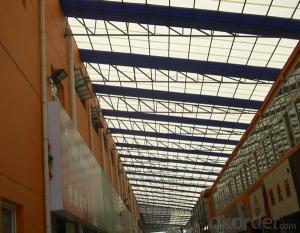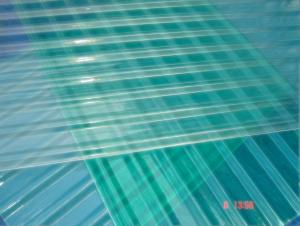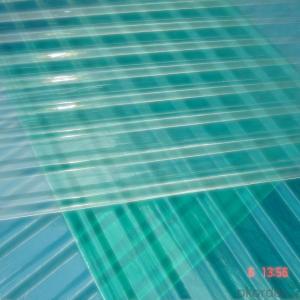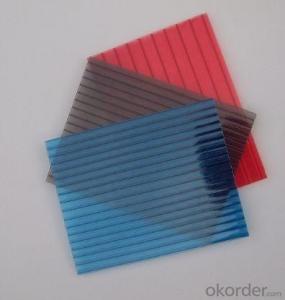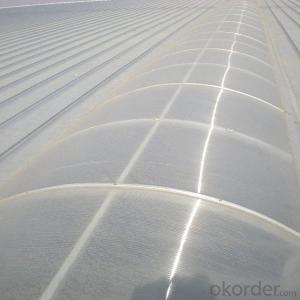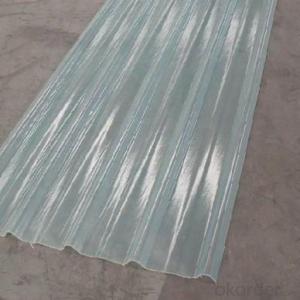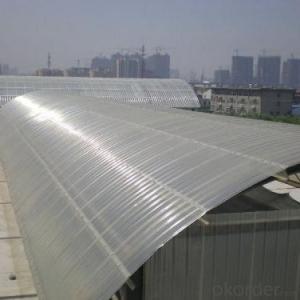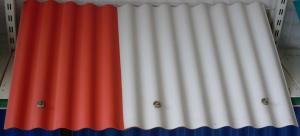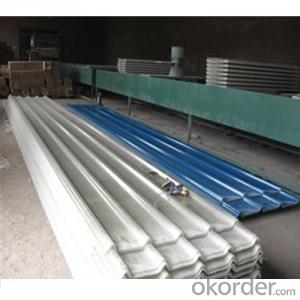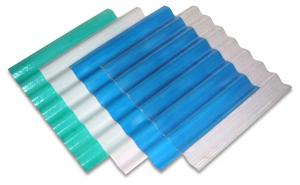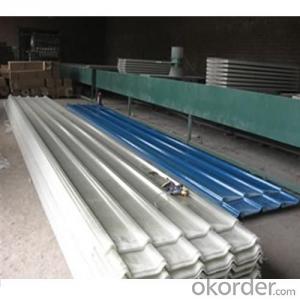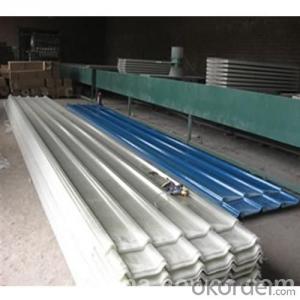Polyethylene Soundproof Steel Roofing Sheets
- Loading Port:
- Tianjin
- Payment Terms:
- TT OR LC
- Min Order Qty:
- 30 m.t.
- Supply Capability:
- 4000 m.t./month
OKorder Service Pledge
OKorder Financial Service
You Might Also Like
Item specifice
COMPANY INFORMATION
CNBM, China National Building Materials Group is a state-owned enterprise in charge of administrative affairs in china buiding materials industry. Established in 1984,CNBM is a large group corporation of building materials with total assets of 25 billion RMB and a total staff of 30,000.CNBM now owns 200 subordinating firms of solely owned and joint-venture companies.
CNBM International Corporation is one subsidiary of CNBM, we focus on offering good-quality products, professional service and complete solution to our customers. Strong delivery capacity, advanced technology & management, strong financing capability and excellent after-sale service are our advantages in sharing international market.
INTRODUCTION
A roof is part of a building envelope. It is the covering on the uppermost part of a building or shelter which provides protection from animals and weather, notably rain or snow, but also heat, wind and sunlight. The word also denotes the framing or structure which supports that covering.
The characteristics of a roof are dependent upon the purpose of the building that it covers, the available roofing materials and the local traditions of construction and wider concepts of architectural design and practice and may also be governed by local or national legislation. In most countries a roof protects primarily against rain. A verandah may be roofed with material that protects against sunlight but admits the other elements. The roof of a garden conservatoryprotects plants from cold, wind, and rain, but admits light.
A roof may also provide additional living space, for example a roof garden.
FEATURES
a. anti-corrosion, non-rusty
b. lightweight and high strength
c. anti-flammable
d. anti-fatigue
e. anti-slippery and safety
f. anti-ageing
g. easy to installation and maintenance
h. excellent electromagnetism property
SPECIFICATION
| Place of Origin: | Hebei, China(Mainland) | Brand Name: | CMAX |
| Model Number: | 2.5 mm | Material: | Synthetic Resin, Synthetic resin & ASA |
| Type: | Double Roman Tiles | Thickness: | 3 mm, 2.5mm, 2.3mm |
| Color: | Red or as customer require | Length: | as customer require |
| Width: | 1 meter | Density: | 1.685 g/CuNaN |
| Fire prevention: | B1 grade | Wave height: | 87.5px |
| Wave spacing: | 500px | Effecitve width: | 0.9m |
PICTURES

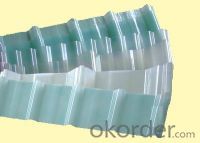

- Q:Can FRP roofing panels be installed on curved roofs?
- Indeed, it is possible to install FRP roofing panels on curved roofs. The flexibility of FRP panels enables them to effortlessly conform to the curves and contours of such roofs. They can be shaped or curved without the risk of cracking or breaking, resulting in a flawless and resilient installation on curved roofs. Nevertheless, it is essential to consider that the level of curvature and the particular design of the curved roof may impact the installation procedure. Therefore, it is advisable to seek guidance from a skilled roofing contractor to guarantee a proper installation.
- Q:Do FRP roofing panels require a specific type of underlayment?
- Yes, FRP (Fiberglass Reinforced Plastic) roofing panels typically require a specific type of underlayment. This underlayment acts as a barrier between the panels and the roof structure, providing additional insulation, moisture resistance, and protection against potential leaks. The specific type of underlayment required may vary depending on factors such as the climate, building codes, and manufacturer recommendations, so it is essential to consult the manufacturer or a roofing professional for the best underlayment choice for FRP roofing panels.
- Q:Can FRP roofing panels be installed on greenhouses or botanical gardens?
- FRP roofing panels are capable of being installed in both greenhouses and botanical gardens. These panels possess numerous advantageous characteristics, including their lightweight composition, durability, and exceptional thermal insulation capabilities. Consequently, they prove to be an optimal choice for such structures. Furthermore, FRP panels exhibit resistance to UV radiation, chemicals, and moisture, all of which are commonly encountered within greenhouse and botanical garden settings. This resistance enables the panels to effectively shield plants from the elements while simultaneously facilitating the transmission of ample natural light. By incorporating FRP roofing panels, one can achieve a cost-effective, long-lasting, and visually appealing solution for maintaining a controlled environment conducive to plant growth in greenhouses or botanical gardens.
- Q:Do FRP roofing panels require edge trims or flashing?
- Yes, FRP (Fiberglass Reinforced Plastic) roofing panels typically require edge trims or flashing. Edge trims are used to create a clean and finished look at the edges of the panels while providing protection against water infiltration and wind lift. They also help to prevent any sharp edges from being exposed, reducing the risk of injury. Flashing is another essential component for FRP roofing panels as it helps to redirect water away from the edges and joints, preventing any potential leaks or water damage. Overall, using edge trims and flashing is highly recommended for FRP roofing panels to ensure proper installation, protection, and longevity of the roof.
- Q:Are FRP roofing panels resistant to wind damage?
- Yes, FRP (Fiberglass Reinforced Plastic) roofing panels are generally resistant to wind damage. FRP panels are known for their durability and strength, making them able to withstand high winds. The fiberglass reinforcement in these panels adds strength and flexibility, allowing them to resist bending or breaking under strong wind forces. Additionally, FRP roofing panels are typically installed with secure fastening systems that help to further enhance their resistance to wind damage. However, it's important to note that the specific resistance to wind damage can vary depending on factors such as the installation method, panel thickness, and the specific wind conditions in a given area. It is always recommended to consult with a professional installer or manufacturer for guidance on the specific wind resistance capabilities of FRP roofing panels for a particular project.
- Q:Are FRP roofing panels suitable for recreational vehicles?
- Yes, FRP (Fiberglass Reinforced Panels) roofing panels are suitable for recreational vehicles. These panels are made from a combination of fiberglass and resin, which makes them lightweight yet durable. They are resistant to corrosion, UV rays, and extreme weather conditions, which are all important factors for RVs that are constantly exposed to the elements. FRP roofing panels also provide excellent insulation properties, helping to keep the interior of the RV cool in hot weather and warm in cold weather. This can greatly enhance the overall comfort level inside the vehicle, especially during long trips. Additionally, FRP panels are easy to install and maintain. They can be easily cut to fit the desired size and shape, allowing for customization and flexibility during the installation process. They are also resistant to mold, mildew, and rotting, ensuring a longer lifespan for the RV roof. Overall, FRP roofing panels are a great choice for recreational vehicles due to their lightweight nature, durability, weather resistance, insulation properties, and ease of installation and maintenance.
- Q:Are FRP roofing panels prone to warping from heavy machinery?
- The durability and resistance to warping of FRP roofing panels are well-known. However, exposure to heavy machinery may result in warping, depending on various factors. To begin with, the resistance to warping of FRP roofing panels is greatly influenced by their thickness and quality. Thicker panels with a higher fiberglass content are less likely to warp under heavy machinery loads compared to thinner or lower-quality panels. Additionally, the type and weight of the heavy machinery can affect the probability of warping. While FRP panels can withstand normal loads like snow or wind, excessive weight from heavy machinery can surpass their load-bearing capacity and potentially cause warping. Moreover, the condition of the underlying support structure is crucial. If the structure is weak or incapable of handling the weight of heavy machinery, it can create localized pressure points on the FRP panels, increasing the risk of warping. Proper installation is also vital in preventing warping. Inadequate fastening of the panels or gaps and uneven pressure distribution during installation can contribute to warping, particularly under heavy machinery loads. To minimize the possibility of warping, it is advisable to seek guidance from a professional roofing contractor with expertise in FRP installations. They can evaluate the specific requirements of the roofing project, taking into account the type and weight of machinery involved, and recommend suitable panel thickness, quality, and installation techniques to ensure maximum durability while minimizing the risk of warping.
- Q:Can FRP roofing panels be used for solar panel installations?
- Yes, FRP (Fiberglass Reinforced Plastic) roofing panels can indeed be used for solar panel installations. FRP panels are known for their durability, thermal stability, and resistance to corrosion, making them suitable for supporting solar panels. They are lightweight yet strong, which makes installation easier and reduces the load on the roof structure. Additionally, FRP panels have excellent UV resistance, which is crucial for protecting the underlying solar cells from sun damage. The smooth surface of FRP panels also aids in the efficient performance of solar panels by reducing dirt buildup and facilitating self-cleaning. Overall, FRP roofing panels are a reliable and cost-effective choice for supporting solar panel installations.
- Q:Can FRP roofing panels be used in modular construction?
- Modular construction can benefit from the utilization of FRP roofing panels. FRP, otherwise known as Fiber Reinforced Polymer, is a resilient and sturdy material frequently employed in construction due to its lightweight composition and resistance to corrosion and weathering. In the realm of modular construction, where buildings are constructed off-site in sections or modules and subsequently transported for assembly at the final location, the incorporation of FRP roofing panels can present several advantages. Firstly, the lightweight nature of FRP panels facilitates their handling and transportation, thereby contributing to the efficiency of modular construction. Moreover, FRP roofing panels offer exceptional insulation properties, thereby aiding in temperature regulation and reducing energy consumption within modular buildings. This is particularly advantageous in modular construction, where the maintenance of energy efficiency is crucial to sustainable and cost-effective building practices. Furthermore, FRP roofing panels exhibit high resistance to inclement weather, enduring extreme temperatures, UV rays, and moisture. This renders them a dependable choice for modular construction, particularly during transportation and assembly, when the durability of building materials is of utmost importance. Lastly, FRP roofing panels provide design flexibility, as they can be manufactured in a variety of colors, finishes, and profiles to align with the aesthetic requirements of the modular construction project. In summary, the lightweight composition, insulation properties, durability, and design flexibility of FRP roofing panels make them an ideal choice for modular construction. Their integration enhances the efficiency, sustainability, and aesthetics of modular buildings.
- Q:Can FRP roofing panels be used for schools?
- Yes, FRP (Fiberglass Reinforced Plastic) roofing panels can be used for schools. FRP roofing panels are known for their durability, longevity, and resistance to various weather conditions. These panels are lightweight, making them easy to install and maintain. Additionally, FRP roofing panels are fire-retardant and can provide excellent insulation, helping to reduce energy costs for schools. The versatility of FRP roofing panels allows them to be used in a variety of school settings, including classrooms, gymnasiums, and administrative buildings. The panels are available in different colors and designs, providing aesthetic flexibility to match the school's architecture. Overall, FRP roofing panels are a practical and cost-effective option for schools, offering long-term benefits and a safe environment for students and staff.
1. Manufacturer Overview |
|
|---|---|
| Location | |
| Year Established | |
| Annual Output Value | |
| Main Markets | |
| Company Certifications | |
2. Manufacturer Certificates |
|
|---|---|
| a) Certification Name | |
| Range | |
| Reference | |
| Validity Period | |
3. Manufacturer Capability |
|
|---|---|
| a)Trade Capacity | |
| Nearest Port | |
| Export Percentage | |
| No.of Employees in Trade Department | |
| Language Spoken: | |
| b)Factory Information | |
| Factory Size: | |
| No. of Production Lines | |
| Contract Manufacturing | |
| Product Price Range | |
Send your message to us
Polyethylene Soundproof Steel Roofing Sheets
- Loading Port:
- Tianjin
- Payment Terms:
- TT OR LC
- Min Order Qty:
- 30 m.t.
- Supply Capability:
- 4000 m.t./month
OKorder Service Pledge
OKorder Financial Service
Similar products
New products
Hot products
Hot Searches
Related keywords
